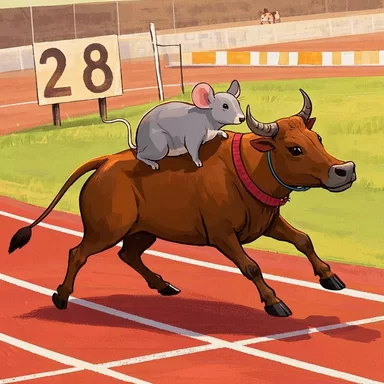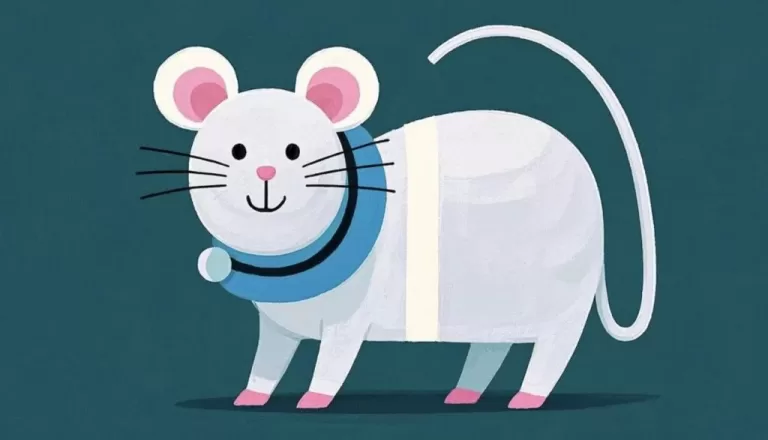Decode the Mysteries of the Chinese Zodiac Ox: Unleash Your Fortune with Ancient Wisdom
The Ugly Ox is one of the twelve Chinese zodiac signs, corresponding to the second of the twelve earthly branches. Oxen are known for their lifelong loyalty to their masters. They toil hard throughout their lives, working diligently without seeking rewards. During the early hours of the morning (Chou time), oxen engage in the most meticulous, slow, and comfortable rumination.
Origin

There are interesting legends about the formation of the Chinese zodiac. One story goes that the Jade Emperor decided to rank the twelve zodiac animals. He initially selected the ox, tiger, rabbit, dragon, snake, horse, sheep, monkey, rooster, dog, pig, and cat, and asked them to come the next day for the ranking. At that time, the cat and the mouse were good friends. The cat told the mouse, “Wake me up early tomorrow. I’m one of the zodiac animals and I need to go to heaven to get ranked.” The mouse readily agreed. However, the next day, the mouse woke up early but didn’t wake the cat. Instead, it went to heaven alone. When it was time for the ranking, the Jade Emperor arranged the animals in the order of ox, tiger, rabbit, dragon, snake, horse, sheep, monkey, rooster, dog, pig, and cat. The Jade Emperor asked if the animals had any objections. Only the mouse objected, saying, “I don’t think the cat should be chosen. It doesn’t respect you at all. Look, it’s still sleeping and doesn’t care about the zodiac ranking.” The Jade Emperor saw that the cat was indeed sleeping. He was furious and decided that the cat would never be allowed to go to heaven again. At the same time, he let the mouse take the cat’s place. The mouse then said, “I must be ranked first!” “Why? Is your contribution greater than that of the ox?” “People think I’m much bigger than the ox.” The Jade Emperor had no choice but to let people judge. So the mouse went to the street and ran across it. People who saw the mouse shouted, “Big (beat) mouse, big (beat) mouse…” Hearing this, the Jade Emperor put the mouse in the first place.
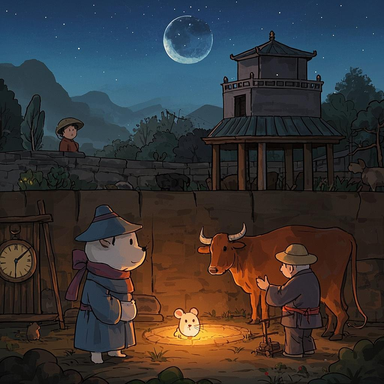
Another theory is that the twelve – zodiac system first emerged in time – keeping. A day and night consist of twenty – four hours. Ancient astronomers divided the day and night into twelve time periods. By observing the living habits and activity times of twelve animals, they determined the twelve zodiac signs. From 11 p.m. to 1 a.m., it is the Zi time, when rats are most active in the quiet night, so it’s called “Zi Rat”. From 1 a.m. to 3 a.m., it’s the Chou time. Oxen are used to grazing at night, and farmers often get up late at night to feed them, thus it’s “Chou Ox”. And so on, the time periods and corresponding animals were paired up, and later this time – keeping method was used for chronological recording, giving rise to the twelve – zodiac system.
Culture
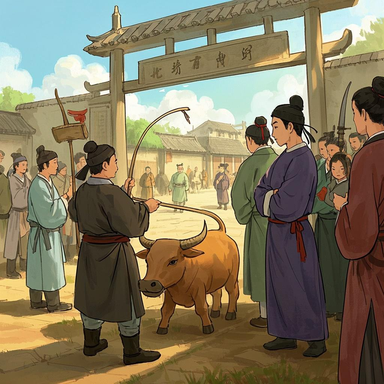
In the poem “Sheng Chun” by Yuan Zhen of the Tang Dynasty, it says, “Whip the ox outside the county gate, compete for soil to cover the spring silkworms.” The act of “whipping” first and then “competing” was part of the ancient custom of sending off the cold of winter and welcoming the spring breeze. Whipping the spring ox, also known as whipping the clay ox, has an early origin. “Zhou Li · Yue Ling” records, “Bring out the clay ox to send off the cold air.” This custom was passed down and was especially popular in the Tang and Song dynasties, especially after Emperor Renzong of the Song Dynasty issued “The Classic of the Clay Ox”, and the custom spread even wider, becoming an important part of folk culture.
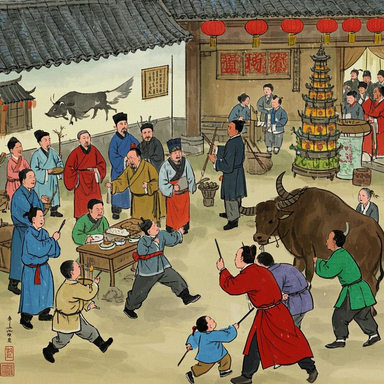
In the “Jinan Fuzhi · Sui Shi” during the Kangxi period, it is recorded that on the day before the Beginning of Spring, the government led the people to bring the spring ox and the god of spring to welcome spring in the eastern suburbs. They made five – spice plates, commonly known as spring plates, drank spring wine, and wore spring flowers. People in the neighborhood and merchants performed plays like fishermen, woodcutters, and farmers. They decorated a spring tower, and children in the streets wore colorful clothes and ghost masks, dancing around, which was an inheritance of the ancient rural exorcism. On the day of the Beginning of Spring, officials used colorful sticks to strike the clay ox three times, called whipping the spring, to show the intention of encouraging farming. They also made small spring oxen and sent them to the homes of gentry, and played drums and music when they arrived at the door, called sending spring. The significance of whipping the spring ox is not only to send off the cold and promote spring plowing but also has certain witchcraft meaning. In Shandong, people break the clay ox, and everyone rushes to grab the soil of the spring ox, called grabbing spring, and it’s considered auspicious to grab the ox’s head. In Zhejiang, when welcoming the spring ox, people kowtow to the spring ox in turn. After that, the common people rush forward to break the spring ox, and then take the clay of the spring ox home and scatter it in the cattle pen, indicating that the clay from the spring – welcomed ox can promote the reproduction of cattle.
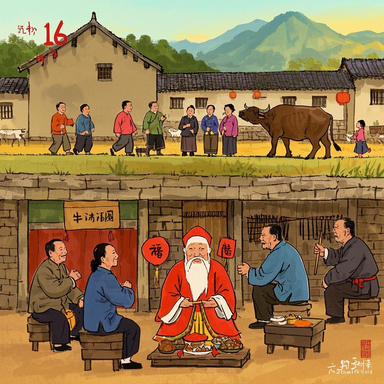
In the Han ethnic group’s customs, there is a saying of “forming an ox – wealth kinship”, which is popular in Hunan. In this area, when several families share one ox, it is called forming an ox – wealth kinship, and they regard each other as relatives. Once the ownership of the ox changes, this “relative” relationship ends. The “Cattle King Association” in Liuba County, Shaanxi, is a term for celebrating the birthday of the elderly. Since the ox plows the fields and benefits people and ranks high in the zodiac, using the ox to name the birthday celebration shows respect for the elderly.
Ox – related Idioms
A single hair out of nine oxen: This idiom is used to describe something of extremely small value or insignificance, or it can also imply stinginess.
Nine oxen and two tigers: It metaphorically refers to an extremely great force.
A master hand’s first small display: It describes a talented person showing a little bit of their ability.
So many books as to make the ox transporting them sweat and to fill a house: This idiom means there are a great number of books.
A clay ox entering the sea: It means something that has gone and will never return, leaving no trace.
Pao Ding dissecting an ox: It implies having a thorough understanding of things and being able to handle things with ease and proficiency.
Playing the lute to a cow: It means talking to someone who doesn’t understand or appreciate.
Getting into a dead – end by splitting hairs: It describes someone with a stubborn mindset, trapped in a dead – end.
A newborn calf is not afraid of tigers: It uses the fearlessness of a newborn calf to metaphorize a person who has just entered society, not afraid of difficulties or evil forces.
A cow licking her calf shows deep affection: It describes the deep love of parents for their children.
Years
The Chinese zodiac assigns an animal sign to each year in a 12-year cycle. The years associated with the “Ox” or “Niú” zodiac sign are as follows: 1901, 1913, 1925, 1937, 1949, 1961, 1973, 1985, 1997, 2009, 2021, 2033, 2045, etc. The calculation of Ox years is based on the Chinese lunar calendar, specifically determined by the zodiac’s connection to the Earthly Branch “Chou” (丑). A year is considered an Ox year if the Gregorian year number divided by 12 leaves a remainder of 5. For example, 2021 ÷ 12 = 168 with a remainder of 5, making 2021 an Ox year. It’s important to note that the zodiac year starts with the Chinese New Year, which typically falls between January 21 and February 20 on the Gregorian calendar, not on the first day of January.

